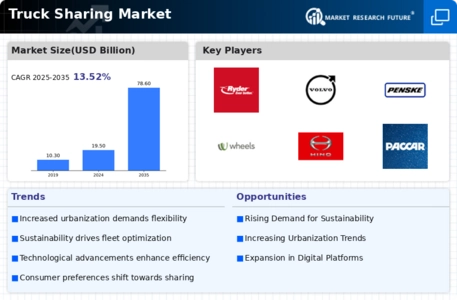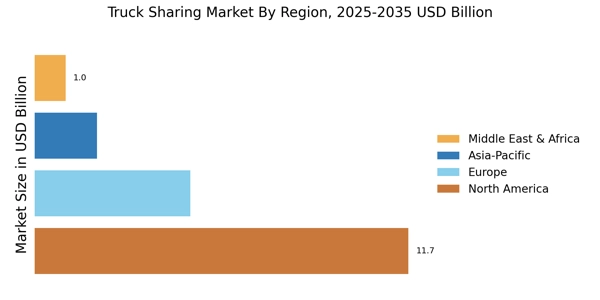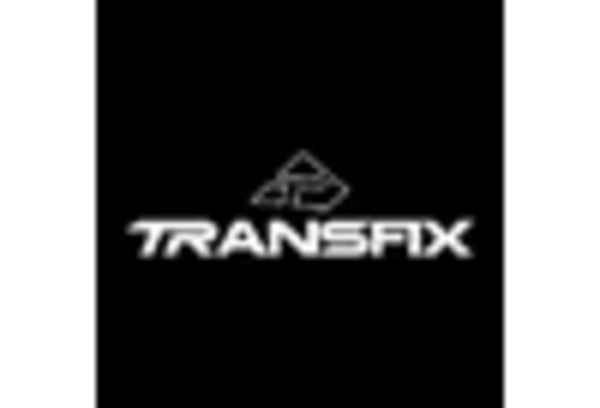Rising Demand for Last-Mile Delivery
The Truck Sharing Market is experiencing a notable increase in demand for last-mile delivery services. As e-commerce continues to expand, businesses are seeking efficient logistics solutions to meet consumer expectations for rapid delivery. This trend is particularly pronounced in urban areas, where the need for flexible transportation options is paramount. According to recent data, the last-mile delivery segment is projected to grow significantly, with a compound annual growth rate of over 15% in the coming years. This growth is likely to drive the adoption of truck sharing services, as companies look to optimize their delivery fleets and reduce operational costs. Consequently, the Truck Sharing Market stands to benefit from this shift, as it offers a viable alternative to traditional logistics models.
Technological Integration and Innovation
Technological advancements are reshaping the Truck Sharing Market, facilitating enhanced service delivery and operational efficiency. The integration of digital platforms and mobile applications has streamlined the process of booking and managing truck sharing services. These innovations enable users to access real-time data on vehicle availability, pricing, and route optimization, thereby improving overall logistics performance. Additionally, the adoption of telematics and IoT technologies allows for better fleet management and monitoring, which can lead to reduced downtime and improved asset utilization. As technology continues to evolve, the Truck Sharing Market is likely to see increased investment in these digital solutions, further driving its growth and appeal to businesses seeking modern logistics solutions.
Cost Efficiency and Operational Flexibility
Cost efficiency remains a critical driver within the Truck Sharing Market. Businesses are increasingly recognizing the financial advantages of utilizing shared truck services rather than maintaining their own fleets. By leveraging truck sharing, companies can significantly reduce capital expenditures associated with vehicle purchase, maintenance, and insurance. Furthermore, the operational flexibility afforded by truck sharing allows businesses to scale their logistics capabilities in response to fluctuating demand. This adaptability is particularly beneficial for small to medium-sized enterprises that may lack the resources for a dedicated fleet. Recent analyses indicate that companies utilizing truck sharing can achieve cost savings of up to 30% compared to traditional logistics methods. As such, the Truck Sharing Market is poised for growth as more businesses seek to enhance their operational efficiency.
Urbanization and Infrastructure Development
Urbanization is a significant driver of growth within the Truck Sharing Market. As populations in urban areas continue to swell, the demand for efficient transportation solutions becomes increasingly critical. The rise in urban congestion necessitates innovative logistics strategies, and truck sharing presents a viable option for businesses looking to navigate these challenges. Moreover, ongoing infrastructure development projects in many cities are enhancing transportation networks, making it easier for truck sharing services to operate effectively. Recent statistics suggest that urban areas are expected to account for a substantial portion of logistics activity in the coming years, further underscoring the importance of truck sharing as a flexible and efficient solution. Consequently, the Truck Sharing Market is well-positioned to capitalize on these trends.
Environmental Regulations and Sustainability Initiatives
The Truck Sharing Market is increasingly influenced by stringent environmental regulations and a growing emphasis on sustainability. Governments worldwide are implementing policies aimed at reducing carbon emissions and promoting eco-friendly transportation solutions. This regulatory landscape is encouraging businesses to adopt truck sharing as a means to minimize their environmental footprint. By utilizing shared vehicles, companies can reduce the number of trucks on the road, leading to lower emissions and improved air quality. Furthermore, the Truck Sharing Market is aligning with sustainability initiatives, as many providers are investing in electric and hybrid vehicles to meet consumer demand for greener options. This shift not only addresses regulatory requirements but also enhances the market's attractiveness to environmentally conscious consumers.


















Leave a Comment